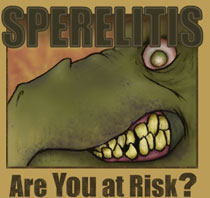|
||
|
||
|
Health Alert: Sperelitis
Find out how you can protect yourself from this devastating disease.
What is Sperelitis?
Sperelitis is an emerging disease that has recently garnered significant concern among the scientific community. The name Sperelitis is derived from the small flying creature, the sperel, for it is the first (and currently the only) species to have displayed the peculiar symptoms of the disease. The more disturbing symptoms of Sperelitis include varying degrees of hysteria and self mutilation in the form of biting and scratching at one's own extremities (most commonly the feet). Curiously enough, the conditions of the afflicted do not interfere with their work performance. Given a task to do, Sperelitis victims can become remarkably well-focused.
What is the cause of the disease?
Thus far, Sperelitis has been successfully contained within the walls of the Plentmire Harvesting Factory at Mulldrum, wherein the disease appears to have originated. Many health experts believe that there is a connection between the disease and the small but significant number of sperels within the factory's shipping railways who have had their wings cut off. One theory suggests that when a sperel's wings are removed, a signal is transmitted to the brain equivalent to that which is received by victims of traumatic experience. Though the circumstances leading up to Disruptive Traumatic Stressfulness and Sperelitis may differ, the effects of these diseases on their sufferers are, as noted, quite similar. Once the wingless sperel begins to display mild signs of mental agitation, their condition almost always accelerates predictably into a more severe state of insanity. There are those, however, who remain unconvinced by the previous theory due to the fact that wing removal has been in practice long prior to the outbreak of Sperelitis. Doctor Fennblant, head of the Outbreak Containment Committee in Mulldrum explains: "The operation is always performed in sterile environments, and has, in the past, never produced undesirable results before." A growing number of scientists point to an unfriendly bacteria that has been discovered on the tips of the severed wings of the infected. Traces of this bacteria have also been found in the victim's blood and saliva, and some researchers believe that this bacteria is the actual cause of Sperelitis, though the origins of the bacteria remain a mystery. Unfortunately, the disease has yet to receive adequate analysis due to the harvesting factory's poor and unregulated standards of cleanliness. Those who are most interested in examining the sperels to learn more about Sperelitis fear the possibility of contamination, and are naturally concerned for their own safety. How does the disease spread?
At its outset, the disease was believed to be non-contagious, but collected evidence has given reason to dispute this belief. Of the 156 sperels who work the shipping railways, 21.79% have become infected. Included in this percentage are two elderly sperels who have yet to undergo wing removal, forcing researchers to consider the cause of the disease's dissemination. Again, bacteria is suspect. The operation of wing removal leaves the sperel with a temporary open sore, providing a susceptible receptor for any foreign bacteria to invade. From here the bacteria can enter the sperel's blood stream, which explains why it also exists in the Sperelitis sufferer's saliva and in their self-inflicted wounds. This understanding, however, leaves only speculation as to why the disease has begun to spread to sperels who still have their wings. "The sperels do not appear to be biting each other and spreading the disease that way,"
says Dr. Fennblant "but it is impossible to tell without an increased measure of monitoring and/or quarantine. In any case, the rising rate of contamination is considerably alarming." Plentmire has made no plans to allow for any additional evaluation of their sperel population, stating that such steps would place an undesirable strain on the melmire industry and would be detrimental to the interests of all.
The procedure of amputating a sperel's wings after their functionality has been exhausted (though willingly accepted and, in fact, requested by the sperels themselves) has been denounced for years by Defenders of Equality for Inferior Creatures (DEIC). "What other outcome could possibly be expected from such horrible treatment?" asks an infuriated representative from DEIC, wishing to remain anonymous. "Only catastrophe. The sperels work hard in bringing the world its supply of melmire. Is this what we call fair repayment - cutting off their wings once they've gotten too old? They should be given adequate comforts for all their hard work at least and nothing less." Scientists are equally concerned and are actively working to alleviate the symptoms of the infected and prevent the disease from spreading. Is Sperelitis curable?
At present, all attempts to cure those infected with Sperelitis have been entirely unsuccessful, though current efforts do seem to be headed in a positive direction. It is possible that a deficiency in the sperels' natural diet may be making them susceptible to a disease to which they would otherwise have developed an immunity. Since the sperel is native to the Joldabrun region, it makes sense to look there for a potential cure. Extracts of the Julapern root and its leaves are being tested as a promising remedy for the disease. Health experts insist that there is no reason at the moment for anyone to add Julapern supplements to their diet. Sperelitis has yet to be found in any other species and there is still no evidence to prove whether or not other creatures are even susceptible to the disease. As future studies reveal a greater understanding of this new disease, additional information about Sperelitis shall be made available to the public. If you wish to take further precautions against this disease, then may we earnestly advise that you read The Flight of A Sperel. |
 |
 |
 |
 |
 |
 |
 |
 |
 |
 |
 |
 |
 |
 |
|
||||||||||||
|














































